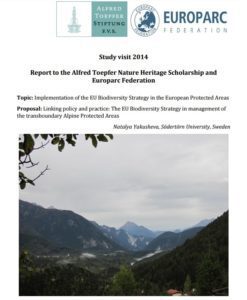Linking policy and practice: The EU Biodiversity Strategy in the management of Transboundary Protected Areas
Triglav National Park © Triglav NP archive
Linking policy and practice: The EU Biodiversity Strategy in the management of Transboundary Alpine Protected Areas
Article issued by Natalya Yakusheva
Every year, the Alfred Toepfer Natural Heritage Scholarship supports the work of young conservationist in protected areas across Europe. Natalya was one of the winners of the Scholarship in 2014.
Biodiversity loss is one of the most severe environmental problems that spans from local to global levels. Consequently, the measures tackling this problem include wide range of political instruments, scientific research, and local actions. However, it is not always easy to trace a link between often abstract political objectives and applied measures.
Natalya Yakusheva conducted her study visit in the Transboundary Julian Alps Ecoregion, which includes Prealpi Giulie Nature Park in Italy and Triglav National Park in Slovenia, to explore the links between the European Union’s and national political objectives for nature conservation, and the day-to-day implementation and management practices in these protected areas.
During a month-long visit, Natalya conducted interviews with park employees, local stakeholders, and scientists, as well as participated in various workshops and field activities in both parks.
How to bridge biodiversity concerns and local communities’ expectations?
The process of designation of protected areas in both countries brought certain dissatisfaction among local stakeholders, who often claim conservation limits the development of different activities. In response to these concerns, the park administration’s work to further develop sustainable tourism and support nature-friendly local agricultural practices to improve local livelihoods.

Sheep grazing in the Prealpi Giulie Nature Park © Natalya Yakusheva
Since 1996, Parks have been cooperating under the framework of the Transboundary Parks Programme, with joint efforts in the fields of conservation, research, education, and rural development. Moreover, in 2016, they have also applied the methodology of the European Charter for Sustainable Tourism in Protected Areas (ECST), becoming the first cross-border Sustainable Destination in Europe. Through the application of the ECST, Parks developed a permanent forum of stakeholders and defined a 5-year action plan, aiming to maximise the socio-economic benefits to their local communities, whilst preserving its natural assets.
Moreover, Parks seek to attract diversified funding for conservation and local development through EU-funded programmes, that allows them to closer engage with the local communities and bring them higher benefits. Despite existing difficulties, they seek to closely engage in the local development processes and keep in contact with relevant stakeholders locally, nationally and internationally.
The parks seek to closely engage in environmental education and extra activities for kids and youngsters from the park municipalities as a way to promote conservation agenda and build a solid foundation among those who will define the face of this area in the years ahead.

Excursion of school kids from Resia municipality, Italy to Nockberge UNESCO MAB, Austria, organised by the Prealpi Giulie park administration © Natalya Yakusheva
Conclusions
The findings of the study visit demonstrated that day-to-day practices of the park administrations are in line with major objectives of the European approach, especially, in regards to public engagement and ways to balance nature conservation and local sustainable development in practice. The latter was recognised both on a formal level, through the inclusion into Management Plans of both parks, and informal level, as the importance of this was acknowledged by interviewees from both sides of the border.
The recognition of these common ways of working for the park and local communities is the first step towards successful long-term policy implementation that brings benefits for nature and for people.
Download the full report here
More on the EU biodiversity political and legal framework:
The Directive on the Conservation of Wild Birds 79/409/EEC
The Directive on the Conservation of Natural Habitats and of Wild Fauna and Flora 92/43/EEC
The Natura 2000 network of protected areas
The call for the Alfred Toepfer Natural Heritage Scholarship 2017 is still open!
If are under 35 and would like to conduct a study tour to European Protected Areas, then this is the perfect opportunity for you. Applications are open to all geographic Europe, for students and staff working for a PA or environmental NGO.
